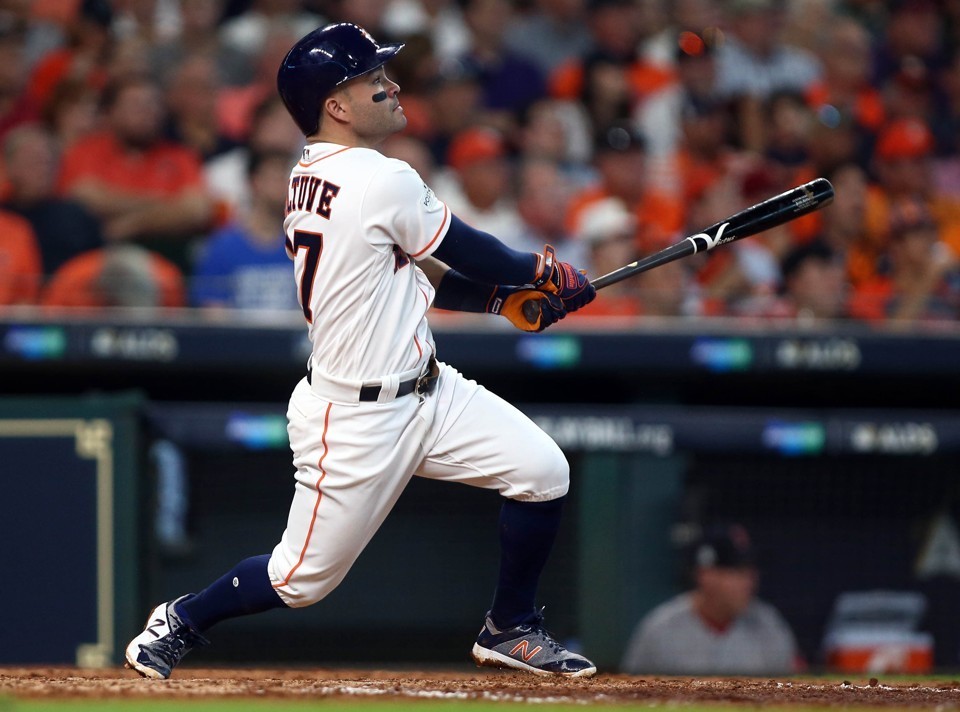If you were to start a team from scratch, which second basemen would you target? You need to factor in not only play, but age and longevity as well. I don’t see any debate over the top spot, but beyond that point someone could go any number of directions. From two through ten there is a lot of jockeying. I did my best to put them in order balancing age and performance, but there are still a few very solid players not inside the top ten.
1. Jose Altuve
The MVP stands head and shoulders above the rest of the crowd, even if he literally stands head and shoulders below them. Altuve has been the best second baseman in baseball over the past four seasons and doesn’t turn 28 until May. During those four seasons Altuve has won three batting titles and led the league in hits all four seasons. He has also led the league in stolen bases twice, won an MVP Award and placed third in another vote. Altuve also collected 22 base hits and seven home runs during postseason play this past year, helping the Astros to their World Series title.
Altuve has proven he can do just about anything at the plate he wants. He has transformed himself from the singles and doubles hitter he was in 2014, to someone who can pop homers over the fence without sacrificing doubles. In 2014 when he batted .341, Altuve only homered seven times while hitting 47 doubles. The last two seasons he has hit 24 home runs in each while still hitting 81 doubles. His average over these past two seasons has been .341, the same it was the year he hit seven home runs. Altuve is remarkable, without even thinking about the fact he stands just 5’6″.
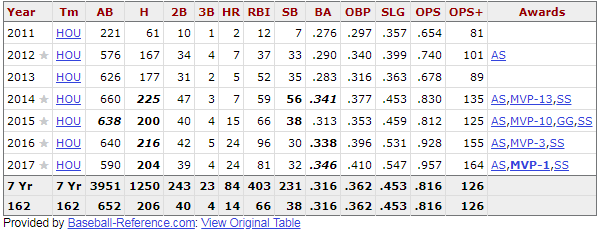
2. Brian Dozier
Brian Dozier is the biggest power hitter at the position. Not only that, he steals some bags and plays excellent defense. Since his first full season, Dozier has averaged 29 home runs and 16 stolen bases per season. His home runs increased each season through 2016, culminating with him setting the American League record for home runs by a second baseman in a season (42). Not like he fell off horribly last year, homering 34 times. Dozier also stole 18 bags in 20 tries in 2016. With 76 home runs and an .871 OPS over these past two years, Dozier seems like he has settled in as a true threat.
As for his defense, Dozier has made less than 10 errors in each of the last three seasons. Last year he only made five all year, putting up a .993 fielding percentage. This led to him winning his first Gold Glove. Dozier is a great all-around player, and turning 31 this May, he should be for a while to come.
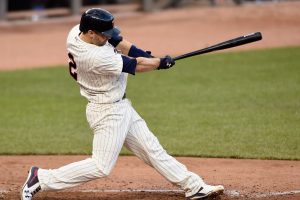
Photo by Hannah Foslien
3. Javier Baez
Baez has been consistently improving since he entered the league with large fanfare in 2014. Baez mashed a lot of home runs in the minor leagues and entered the 2014 season as the 5th best prospect in baseball according to Baseball America. He wasn’t ready for the majors though, striking out in over 40% of his plate appearances that season. Baez still rarely walks and has a lot of swing and miss in his game, but has cut back his strike out rate significantly. He has also batted .273 two seasons in a row after hitting .169 that first year. Baez homered 23 times last year and posted a .480 slugging percentage. At just 25 years old for this season, Baez can be expected to make continued improvements.
Baez is stellar in the field as well. It seemed like every night there was some highlight of him making a play this past season. He played a lot of shortstop this past season as well, but second base is his most likely position moving forward. His added versatility only makes him more valuable though. Baez has posted 3.1 dWAR over the past two seasons.
4. Jonathan Schoop
Schoop was a solid prospect, but no one expected quite what he did last year. Schoop has improved with each season he has been in the big leagues, going from a .209 hitter in 2014 to the one we saw last year. He batted .293 and hit 32 home runs last year while making his first All-Star Game. He does have his subtractors though; Schoop struck out 142 times against just 35 walks last year. This was after walking just 21 times the year before.
At just 26, maybe Schoop should be ahead of Baez at least based on last year. However, based on his approach at the plate I don’t expect Schoop to ever duplicate what he accomplished last season. I see him being closer to the hitter he was in 2016, when he batted .267 with 25 home runs while posting a .752 OPS. He is still a good player, but not the star we saw last year. Time will tell if I am wrong. One more added bonus to Schoop is his ability to play every day. Schoop has only missed two games over the last two seasons.
5. Daniel Murphy
If this list were just for this season, Murphy would place second or third. However, Murphy is 33 years old on April 1st, so his position drops a bit. Murphy also isn’t the best fielder, posting a negative dWAR in six straight seasons. Murphy is one of the very best hitters though, so his spot is safe. From 2011-2015, Murphy batted .291 while averaging 10 home runs per year. He has always been a solid hitter. Since then, Murphy has made adjustments to his approach at the plate and started hitting the ball in the air more.
Murphy took the postseason by storm in 2015 when trying to do more damage with his at-bats. He hit seven home runs in the playoffs and won NLCS MVP. He continued with this new approach and has homered 48 times the last two years while leading the league in doubles both seasons. In 2016, he came in 2nd in the MVP vote after leading the league with a .985 OPS. He has batted .334 while averaging 24 home runs, 45 doubles and a .956 OPS over those seasons. At 33, he shouldn’t decline for a couple of years still, but he also doesn’t have nearly the time left of most others on this list.
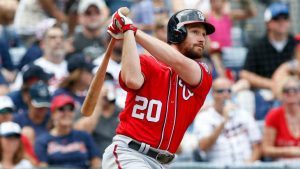
6. Ozzie Albies
Albies doesn’t even have a full season in the Major Leagues, but he looks like a potential star. Albies was on all prospect lists the past two years, and came in at number 11 on Baseball America heading into last year. He batted .304 over parts of four minor league seasons. A line drive hitter, Albies has added a little bit of pop in recent years, as power usually develops with age. He isn’t expected to ever be a power hitter, but he could hit 15 home runs while hitting for good averages. Last season he hit 15 home runs between AAA and the majors. He hit .286 with six home runs over his first 217 Major League at-bats last year.
Albies also has a lot of speed. He stole 102 bases in his minor league career. That’s over 25 stolen bases per season and he wasn’t even playing full seasons in two of those. Last year, Albies stole 21 bases in 23 tries at AAA Gwinnett. After being called up to Atlanta, he stole eight more bases while only being caught once. Albies is also expected to have a good glove, and he made only three errors with a .987 fielding percentage with the Braves.
7. D.J. LeMahieu
Whether or not you want to argue about the affects of Coors Field, D.J. LeMahieu is an excellent hitter. LeMahieu has only surpassed 100 strike outs in one season, consistently putting the ball in play. Over the past three years he has made two All-Star Games and batted .319. LeMahieu has batted over .300 in each of those seasons and won the batting title in 2016. Even playing in Coors, he doesn’t have much power, but with averages like that does it really matter?
LeMahieu is also a stellar defender at second, making just 34 errors across parts of seven seasons. He has never made double digit errors in any season, giving him a career .991 fielding percentage at the position. LeMahieu was able to capture his second career Gold Glove this past season.
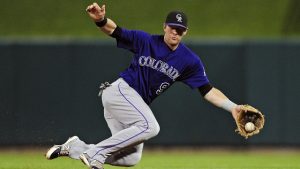
8. Yoan Moncada
This selection is all about projection. At just 22, Moncada has not shown much at the big league level yet. He batted just .231 this past season, although he did put up a .338 on-base percentage. He also managed to hit 8 home runs in 199 at-bats, showing his power potential.
Moncada’s reason for showing here is his big-time potential. Moncada was third in Baseball America’s prospect rankings for 2016, and 2nd for 2017. He has not only shown power potential, but the ability to steal a lot of bases. In 2015 he stole 49 bases while only being caught three times. The next year he stole 45 bags while hitting 15 home runs. His steals have dwindled the higher he has climbed, but between AAA and the White Sox last season he did post a 20-20 season. He has the lowest floor of anyone on this list, but one of the higher ceilings.
9. Rougned Odor
Odor is not your typical second baseman. Odor strikes out a lot, never walks and hits a lot of home runs. That is someone you might expect to find at first base or DH. His power at second base is hard to ignore entirely for this list, but his questionable ability to get on base drops him down to a fringe candidate. Odor was much better the two seasons prior to last year, so based on that potential I am including him.
Odor put up a .791 OPS his first two full seasons despite drawing just 42 walks. In 2016, he homered a lot more often than he drew a walk, 33-19. It was a very strange season, as he put up a weak .296 on-base percentage but had a stellar .502 slugging percentage. Last year he homered 30 times again, and upped his walks to a still meager 32. However, his average tanked, hitting a paltry .204 for the season. I am going to assume he is better than that and put him ninth.
10. Robinson Cano
There are several options still left for this tenth spot, but I am giving the nod to the future Hall of Famer. Cano is approaching top ten all-time status at second base, if he isn’t already. But Cano is 35 now and has shown signs of decline. He is still a very good player, but being so much older and already on the decline he doesn’t have as much value as these younger players.
Cano was awesome two years ago, bashing a career high 39 homers to go with his .882 OPS. However, his other three seasons in Seattle, although good, have been far inferior. Last year he dropped off to .280 with 23 home runs. That season was more in line with what he did in 2015, leaving 2016 as a massive outlier. So in those other two seasons surrounding 2016 he has batted .284 with an average of 22 home runs per season and an OPS below .800. That seems to be more the player Cano is right now. Whereas that is still good, he only has maybe two or three seasons left like that.

Seattle Mariners’ Robinson Cano watches his two-run homer at Yankee Stadium.
Credit: Adam Hunger-USA TODAY Sports
Honorable Mentions:
Whit Merrifield, Starlin Castro, Scooter Gennett, Dustin Pedroia, Cesar Hernandez
Feature picture from The Atlantic
